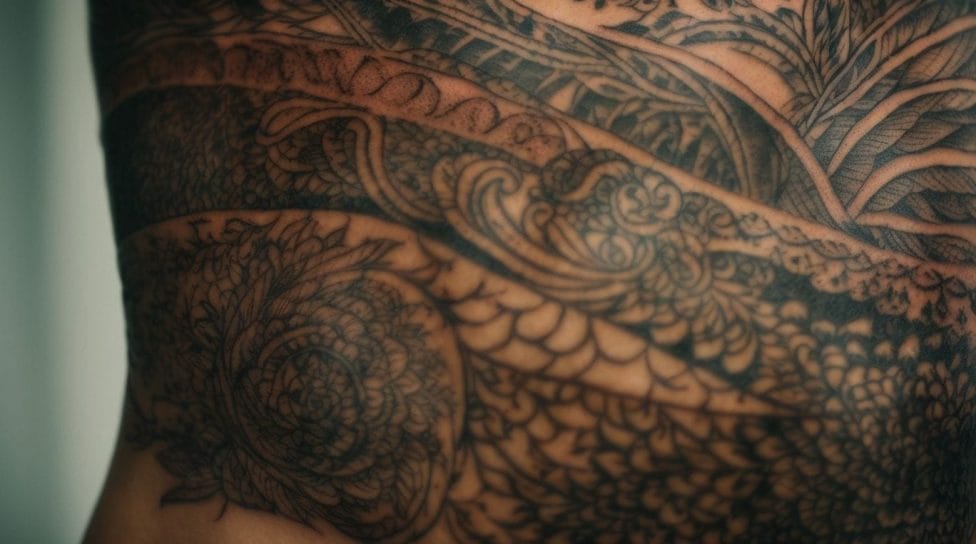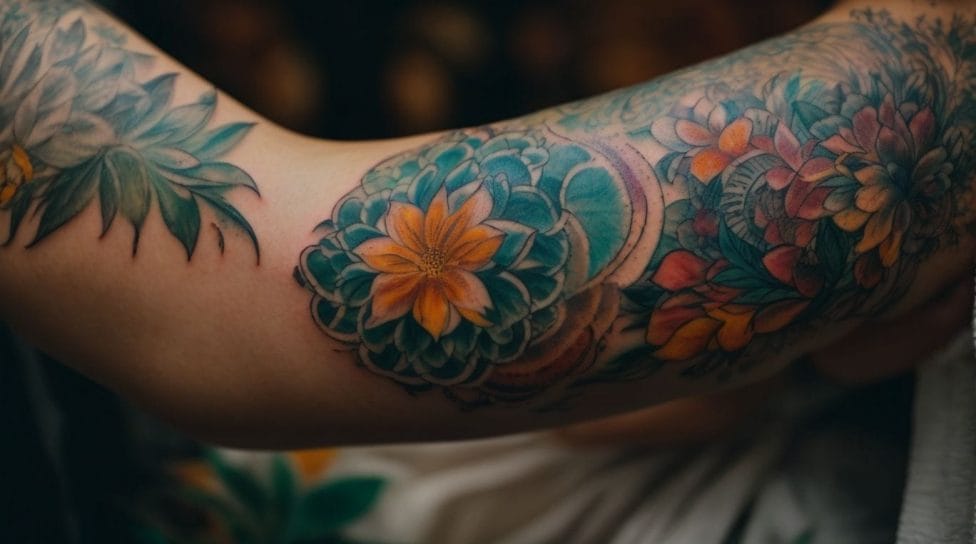Tattoos have become a popular form of self-expression, but for many people, concerns about pain can deter them from getting inked. When considering a tattoo, the pain factor is an important consideration. Specifically, if you plan to get a tattoo on your stomach, you may wonder how much it will hurt. Understanding the tattooing process and the factors that affect pain perception can help you prepare for your stomach tattoo experience.
Tattooing involves inserting ink into the dermis layer of the skin using a needle, creating a permanent design. The pain experienced during tattooing varies from person to person and can be influenced by several factors. First, the tattoo’s placement plays a role in discomfort. Different body areas have different sensitivity levels and may be more or less painful to tattoo.
Individual pain tolerance also plays a significant role. Each person’s pain threshold is unique, and what may feel uncomfortable to one person may be more manageable for another. Existing medical conditions, pain sensitivity, and previous tattoo experience can impact pain perception.
When it comes specifically to getting a tattoo on the stomach, it’s important to consider the nature of the area. The stomach area is generally sensitive, containing various nerve endings and thinner skin. However, the pain level experienced during stomach tattooing can vary depending on factors such as the specific location of the stomach and the individual’s pain tolerance.
If you’re concerned about the pain of getting a stomach tattoo, there are several strategies to help manage discomfort. First and foremost, choosing a skilled and experienced tattoo artist is crucial. A professional artist will have techniques to minimize pain and ensure a comfortable experience. Using numbing creams or sprays can help dull the sensation during the tattooing process. Deep breathing and relaxation techniques can also help you manage pain and stay calm during the procedure.
Aftercare for stomach tattoos is essential to promote proper healing and minimize discomfort. This includes cleaning and moisturizing the tattooed area regularly to prevent infection and keep the skin hydrated. It’s also important to avoid tight clothing and irritants that can rub against the tattoo and cause further discomfort.
While getting a tattoo on the stomach may involve some level of pain, understanding the process, considering individual factors, and utilizing pain management techniques can help make the experience more bearable. By following proper aftercare practices, you can ensure the healing process is smooth and minimize any discomfort associated with your stomach tattoo.
Key takeaways:
- Tattoo pain varies based on placement: Stomach tattoos can be painful due to the sensitive skin, thin layer of fat, and proximity to bones. Pain can differ from person to person.
- Managing pain is possible: Choosing an experienced artist, numbing creams or sprays, and relaxation techniques like deep breathing can help minimize pain during a stomach tattoo session.
- Proper aftercare is crucial: Cleaning and moisturizing the tattooed area, avoiding tight clothing and irritants, and following the tattoo artist’s instructions ensure proper healing and minimize discomfort.
How Does Tattooing Work?

Photo Credits: Tattooineplanet.Com by Charles Davis
When getting a tattoo, understanding how the process of tattooing works is essential. Tattooing involves inserting ink into the skin using a needle. First, the skin is cleansed and prepared. Then, the tattoo artist uses a machine to puncture the skin repeatedly, depositing ink into the dermis. The ink then becomes permanent as it is trapped in the skin. The depth and speed of the needle, along with the artist’s technique, determine the outcome of the tattoo. To ensure a successful tattoo, it’s important to choose a reputable artist and follow proper aftercare instructions. Pro-tip: Before getting inked, research different tattoo styles and find a design that truly resonates with you.
Factors Affecting Pain Perception

Photo Credits: Tattooineplanet.Com by Samuel Clark
Curious about whether tattoos on the stomach hurt? Let’s explore the factors influencing pain perception in tattooing. From the tattoo’s placement to an individual’s pain tolerance, we’ll uncover how these variables can impact the perceived pain during stomach tattooing. So, let’s dive in and discover what makes stomach tattoos a topic of fascination regarding pain levels.
Tattoo Placement
When it comes to tattoo placement, there are several factors to consider to ensure a successful and satisfying tattoo experience. Here are some steps to naturally incorporate the provided keyword “Tattoo Placement” and guide you in choosing the right placement for your tattoo:
- Consider tattoo placement visibility: Decide if you want your tattoo to be easily visible or prefer a more discreet location.
- Think about pain tolerance about tattoo placement: Different areas of the body may be more or less painful to tattoo, so consider your pain tolerance when choosing the placement.
- Consider the design and its compatibility with tattoo placement: Some tattoo designs may work better on certain areas of the body, so take the design into account when selecting the placement.
- Consult a tattoo artist for professional guidance on tattoo placement: Professional tattoo artists have expertise and can provide valuable guidance and recommendations based on your desired design and body type.
- Consider future changes that may affect tattoo placement: Remember how the tattoo placement might be affected by any future changes in your body, such as weight gain or loss.
These steps will help you decide and find the perfect placement for your tattoo.
Individual Pain Tolerance
Individual pain tolerance plays a crucial role in determining the level of discomfort experienced during a stomach tattoo. Some individuals possess a higher pain threshold and can endure the sensation of tattooing more easily. In contrast, those with a lower pain tolerance may find the process to be more painful. Various factors, including genetics, psychological aspects, and prior experiences with pain, can impact an individual’s pain tolerance. It is essential to have a conversation with your tattoo artist about your pain tolerance beforehand. They may be able to make adjustments to the tattooing process, ensuring that any discomfort is effectively managed.
Does Getting a Tattoo on the Stomach Hurt?

Photo Credits: Tattooineplanet.Com by Bryan Martinez
Curious about getting a tattoo on your stomach? Wondering just how much it might hurt? In this section, we will explore the world of stomach tattoos and dive into the pain level that comes with them. Let’s look closer at the stomach area and determine what to expect when getting inked in this sensitive region. Pain thresholds, adrenaline rushes, and the overall experience await – it’s time to uncover the truth about stomach tattoos!
Overview of the Stomach Area
The stomach area, also known as the abdominal region, is a crucial part of the digestive system. Located between the chest and the pelvis, it plays a vital role in breaking down food and absorbing nutrients. When planning to get a tattoo on the stomach, it is imperative to have a comprehensive understanding of the anatomy and characteristics of this area. By considering an overview of the stomach area, one can ensure a well-informed decision.
The stomach area boasts a relatively large surface area, providing ample space for various tattoo designs. However, it is essential to note that the skin in this region is generally sensitive and may be prone to stretching and weight fluctuations. These factors can potentially impact the appearance of the tattoo over time. Nonetheless, the stomach area serves as a versatile canvas for tattoo enthusiasts. To achieve the best outcome, it is crucial to thoroughly consider the design and placement and ensure proper aftercare is practiced.
Pain Level during Stomach Tattooing
During stomach tattooing, the pain level can vary depending on several factors, including tattoo placement and individual pain tolerance. Areas with more fat or muscle tend to be less painful, while areas with thinner skin or close to bones can be more painful. It is essential to note that pain levels are subjective and can vary from person to person. Therefore, discussing your concerns with your tattoo artist and employing pain management techniques can help ensure a more comfortable stomach tattooing experience.
Tips to Manage Pain during a Stomach Tattoo

Photo Credits: Tattooineplanet.Com by Douglas Johnson
Are you looking to get a stomach tattoo but worried about the pain? Don’t fret! In this section, we’ve got you covered with some fantastic tips to manage the pain during your stomach tattoo session. From finding the right tattoo artist to exploring the world of numbing creams and sprays and even incorporating deep breathing and relaxation techniques, we’ll help you navigate the pain and make your tattoo experience as comfortable as possible. No more second-guessing; let’s dive in and conquer that stomach tattoo like a pro!
Choose the Right Tattoo Artist
- When choosing the right tattoo artist, it is crucial to consider various factors for getting a stomach tattoo.
- One of the most important factors is experience. Look for an artist who has expertise specifically in stomach tattoos. This ensures that they understand the unique challenges and techniques involved.
- Another aspect to consider is the artist’s portfolio. Take the time to review their previous work to ensure that their artistic style aligns with your vision for the tattoo.
- Don’t forget about hygiene and safety. It is essential to choose an artist who follows proper sanitation procedures and uses sterile equipment to prevent any infections or health risks.
- Effective communication is key. Select an artist who listens to your ideas, provides suggestions, and communicates openly.
- Consider reading reviews or seeking recommendations from friends. This will help ensure that the artist has a good reputation and has delivered satisfactory results to their clients.
By thoughtfully selecting the perfect tattoo artist, you can ensure a positive experience and achieve a stomach tattoo that exceeds your expectations.
Numbing Creams or Sprays
Using numbing creams or sprays can greatly assist in reducing pain while getting a stomach tattoo. There are various options available that you can consider.
1. Numbing creams: These creams are topical anesthetics that effectively numb the skin’s surface. It is advised to apply the cream to the tattooed area before starting the session. Some popular examples of numbing creams are Emla and Dr. Numb.
2. Numbing sprays: Similar to creams, these sprays also contain anesthetic ingredients which help desensitize the skin. They are quite convenient to apply and are quickly absorbed by the skin. Vasocaine and Hush are a couple of well-known examples.
3. It would be beneficial to consult with your tattoo artist as well. They may have specific recommendations for numbing products or techniques they prefer to use during the tattoo process.
Always remember to carefully follow the instructions provided by the manufacturer and consult with your tattoo artist before using any numbing creams or sprays.
Deep Breathing and Relaxation Techniques
Deep breathing and relaxation techniques are effective methods for managing the pain and discomfort that can arise during a stomach tattoo. To ensure a more relaxed state, consider the following steps:
1. Focus on your breath: Engage in deep breathing exercises by inhaling slowly and exhaling through your mouth. This intentional breathing promotes relaxation and helps ease any discomfort.
2. Mindfulness: Stay present and aware of your body sensations during the tattoo process. Instead of fixating on the pain, focus on your breath to redirect your attention and maintain a sense of calm.
3. Visualization: Utilize the power of imagination by envisioning yourself in a serene place, like a beach or a forest. This mental distraction can divert your mind from the pain and contribute to a more relaxed state.
4. Progressive muscle relaxation: Start by consciously tensing and then releasing each muscle group, beginning from your toes and gradually moving up. This systematic approach helps release tension and enhances overall relaxation.
5. Positive affirmations: Boost your confidence and reduce anxiety by repeating positive statements to yourself, such as “I am strong” or “I can handle this.” These affirmations can provide you with a more optimistic mindset throughout the tattooing process.
By incorporating these techniques into your experience, you can effectively manage the pain and discomfort associated with a stomach tattoo through deep breathing and relaxation.
Aftercare for Stomach Tattoos

Photo Credits: Tattooineplanet.Com by Peter Scott
Taking care of your stomach tattoo is crucial for its healing and long-term appearance. In this section, we will explore the essential aspects of aftercare that will ensure the best outcome for your stomach ink. From proper cleaning and moisturizing techniques to avoiding tight clothing and irritants, we will discuss all the necessary steps to keep your stomach tattoo looking vibrant and vibrant. So, let’s dive in and learn how to take care of your stomach tattoo like a pro!
Cleaning and Moisturizing
To maintain the vibrancy and longevity of your stomach tattoo, it is essential to properly clean and moisturize it. Follow these steps:
- Begin by gently washing the tattooed area using mild soap and lukewarm water.
- Afterward, pat the tattoo dry with a clean towel, avoiding rubbing or harsh movements.
- To keep the skin hydrated, apply a thin layer of fragrance-free moisturizer or tattoo aftercare ointment.
- Avoid picking or scratching the tattooed area to prevent infection and scarring.
- Continue with regular cleaning and moisturizing until the tattoo is fully healed.
Additionally, apart from these steps, it is crucial to avoid exposing the tattoo to direct sunlight, swimming in chlorine or saltwater, and wearing tight clothing that may cause skin irritation. The history of tattooing dates back thousands of years, with the oldest recorded evidence found in ancient Egypt around 2000 BC. Egyptian mummies have been discovered with tattoos, highlighting the long-standing history and cultural significance of this art form. While tattooing techniques and styles have evolved, proper cleaning and moisturizing remain vital aspects of tattoo aftercare.
Avoiding Tight Clothing and Irritants
To ensure proper healing and minimize discomfort after getting a stomach tattoo, it is crucial to actively avoid wearing tight clothing and exposing the area to irritants. By opting for loose and breathable fabrics, you can allow the tattoo to breathe and prevent any friction or irritation that might impede the healing process. Additionally, it is essential to steer clear of harsh soaps, perfumes, and excessive sun exposure, as these can lead to inflammation and prolong the healing time. Following these guidelines diligently will effectively safeguard your stomach tattoo and guarantee a proper healing process. Don’t forget to consult your tattoo artist for personalized aftercare instructions.
Some Facts About Do Tattoos on Stomach Hurt?:
- ✅ Stomach tattoos can be painful due to the sensitive and thin skin in that area. (Source: certifiedtattoo.com)
- ✅ The pain experienced during a stomach tattoo session is generally bearable and fades relatively quickly. (Source: certifiedtattoo.com)
- ✅ Side tattoos, similar to stomach tattoos, can also be painful due to thin skin and proximity to bones. (Source: certifiedtattoo.com)
- ✅ Side tattoos are rated at a high pain level of 8 out of 10, similar to rib tattoos. (Source: certifiedtattoo.com)
- ✅ The pain level experienced during a stomach tattoo will depend on individual pain tolerance, design complexity, and the artist’s technique. (Source: certifiedtattoo.com)


